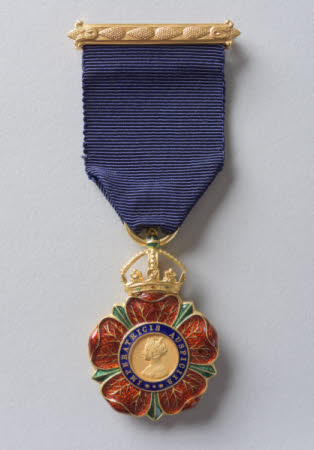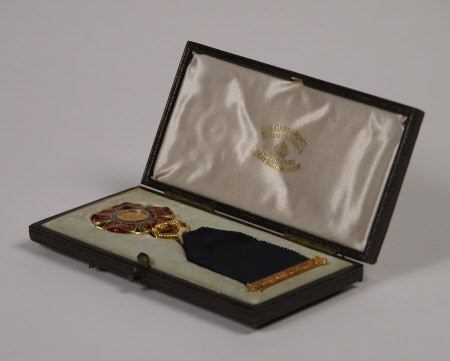Companion of the Most Eminent Order of the Indian Empire
Category
Coins and medals
Date
1887
Materials
Enamel, Gilt, Silk
Measurements
110 x 53 mm
Order this imageCollection
Bateman's, East Sussex
NT 760704
Summary
Companion of the Most Eminent Order of the Indian Empire (CIE) medal awarded to John Lockwood Kipling (1837-1911) in 1887. Five-petalled, crown-surmounted red flower, with the profile image of Queen Victoria surrounded by a dark blue ring bearing the motto 'Imperatricis Auspiciis' (Latin for 'Under the auspices of the Empress'). Awarded to Kipling for his work on the Colonial and Indian Exhibition which opened in South Kensington on 4 May 1886.
Full description
Kipling was awarded a Companion of the Most Eminent Order of the Indian Empire (CIE) for his work on the Colonial and Indian Exhibition which opened in South Kensington on 4 May 1886. He did not receive it however, until the New Year’s honours list, on 1 January 1887, after the close of the exhibition, whereas several of the more senior figures associated with the show had been given honours during the summer, when it was still on. Kipling was named in the press as one of the most significant of the unrecognized organizers. The eventual award may have been the result of public pressure. Kipling, who started his career as an architectural sculptor, spent much of his career teaching in India, first at the Sir Jamsetjee Jeejeebhoy School of Art in Mumbai, and then for eighteen years as Principal of the Mayo School of Industrial Arts in Lahore (today Pakistan’s National College of Arts) and Curator of the Lahore Museum. Text adapted from Susan Weber, ‘Kipling and the Exhibitions Movement’ in ‘John Lockwood Kipling: Art & Crafts in the Punjab and London’, Bard Graduate Center Gallery, New York and Yale University Press, 2017, pp. 258-9.
Exhibition history
Lockwood Kipling: Arts and Crafts in the Punjab and London, Victoria and Albert Museum, South Kensington, 2017 - 2018
References
John Lockwood Kipling: Arts & Crafts in the Punjab and London (Ed.Julius Bryant and Susan Weber) published in conjunction with the exhibition, the Victoria & Albert Museum, 14 Jan - 2 Apr 2017; Bard Graduate Center, New York: 15 Sept 2017 - 7 Jan 2018., cat. 145

